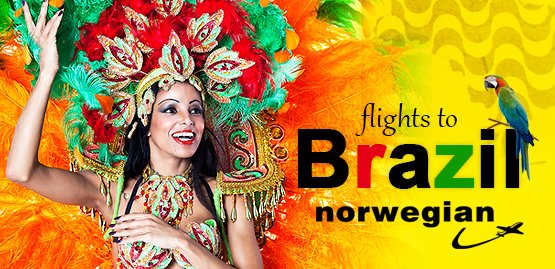






Cheap one-way & return flights to Brazil
How do you get the cheapest flights to Brazil from the UK?
Begin your search early to find the cheapest flights from the UK to Brazil. It gives you time to explore airlines, their flight routes and fares. Consider booking low-deposit flights to secure your seats well in advance without any financial pressure. You can save more on flights by choosing to fly out on Tuesday or Wednesday. Early spring is the low-travelling season for Brazil; therefore, we have observed a significant price drop on flights around that time. Moreover, set up a price drop alert to get notified about seasonal discounts and promotional offers.
Which airlines operate flights to Brazil from UK?
- British Airways
- Lufthansa
- Azul Airlines
- Air France
- Lufthansa
- Avianca
- Tap Portugal Airlines
- United Airlines
- Japan Airlines
Which is the cheapest month to book flight for Brazil?
The rule of thumb is to book flights well in advance to get the cheapest fares to flights to Brazil. It is ideal to book the flight at least two to three and a half months before you intend to depart for Brazil. The low season in the tourism business in Brazil is in the months of April to June, when the rains have finally moved on and the summer vacations have not yet started.
Are there any direct flights to Brazil?
Yes, many reputed airlines operate direct flights to Brazil. The national flag carrier of both the remote countries, British Airways and Latam Airlines are the most preferred airlines for direct flights to Brazil.
How long is the flight from UK to Brazil?
- Heathrow to Brazil (GIG): 8 hours and 5 minutes
- Heathrow to Brazil (GRU): 7 hours and 45 minutes
- Heathrow to Brazil (BSB) on a one-stop flight: 9 hours and 30 minutes
- Manchester to Brazil (GIG) via Paris: 10 hours and 5 minutes
- Birmingham to Brazil (GIG): 10 hours and 20 minutes
What are the main international airports in Brazil?
There are a total of thirty-three international airports in Brazil. Among the busiest airports in Brazil are the Guarulhos International Airport (GRU) at Sao Paulo, the Presidente Juscelino Kubitschek International Airport (BSB) at Brasilia and the Rio de Janeiro–Antonio Carlos Jobim International Airport (GIG) at Rio de Janeiro. Altogether these airports handle approximately 70 million people every year.
Guarulhos International Airport (GRU) at Sao Paulo is the second busiest airport in Latin America, second only to Mexico City Airport. The airport has two parallel runways both more than 3 kilometres long and sixty metres wide. The cargo terminal of the airport has been built to handle even refrigerated and hazardous shipments.
Presidente Juscelino Kubitschek International Airport (BSB) at Brasilia is a newly built airport in the young city. The airline consortium Inframerica invested R$ 1.2billion on the airport's infrastructure and jetways. As a result, the airport now serves approximately 14 million passengers every year.
The Rio de Janeiro–Antonio Carlos Jobim International Airport was refurbished for USD $ 431 million in preparations for the 2014 FIFA world cup. The airport has served 16,243,253 passengers in 2017.
What are the visa requirements for brazil?
UK travellers don’t require a visa to travel to Brazil for a short stay. However, if your stay is for a total of 90 days, either for work or study, you must acquire a visa. On the contrary, if you are only transiting through Brazil without leaving the airport, you do not need a transit visa. Your passport must be valid for at least 6 months, and you do not need any other vaccinations for your travel to Brazil.
What is the best time to visit Brazil?
Generally speaking March to November is the ideal time to visit Brazil. From December to February Brazil receives heavy rainfall. The tropical areas of the country, including the rainforest regions of Pantanal and the Amazon, remain warm and humid throughout the year. So, stuff some shorts and shirts into your backpack and come roll on the warm beaches of Brazil.
Which events and festivals are celebrated in Brazil?
All celebrations seem dull and bland when compared to the Rio Carnival. The Rio Carnival is the place to be at the time of Lent (February) and for five days straight Brazil gushes out with torrents of colour, music and glamour. All of the two million people attending the festival dance with the Samba music.
Festa does Peao or the 'Festival of the Cowboys' is another captivating festival of Rodeo Showdown. The biggest bulls and the burliest men gallop and jolt each other as the stopwatch counts the number of seconds the cowboy has successfully handled the beast. The Festival usually gathers crowds by the dozens of thousands.
Oktoberfest is the festival of beer and food. Generally, Oktoberfest is regarded as a German festival, but Brazil has evolved the festival into its own unique version. So pick up the pint, clang it with a couple of strangers and by the time you swallow the last gulp, call those strangers your new best friends.
The Celebration of Yemanja is a pagan custom that has continued through to this day. The festival is a tribute to the Sea goddess Yemanja who the locals believe protects the ships and provides bountiful fish. The tourist witnesses devotees throwing flowers, perfumes and jewellery into the sea to appease the goddess.
Cirio de Nazare is an annual pilgrimage that forms into a festival that revolves around the Statue of the lady of Nazareth. The statue is believed to have miraculously appeared back in Icoraraci after it had been transported to Belem. The pilgrimage is to mimic this holy teleportation, and pilgrims travel by road or sail on the Amazon river along with the statue
Which Are the famous Landmarks In Brazil?
- The biodiversity that Brazil boasts is beyond comparison. Brazil is the fifth largest country in the world. Brazil has plenty of landmarks and cultural hubs for the tourist to visit. The country has waterfalls, beaches, canyons and impressive buildings throughout its land. To visit Brazil is like being thrown into a kaleidoscope of colour and magic.
- Iguazu Falls are in the south of Brazil. The Iguazu Falls are at the border of three major countries of South America: Brazil, Paraguay and Argentina. Iguazu Falls are the largest waterfall system in the world. Waterfalls upon waterfalls cascade the eighty-metre cliff of the landmark. The total width of the waterfalls is 2.7 kilometres from edge to edge. So great is the waterfall’s expanse that when the First Lady of the United States Elenor Roosevelt came to visit she exclaimed “Poor Niagara!”
- The white sands of Copacabana Beach are warm, clean and welcoming. If the city of Rio de Jinero was a diamond necklace than the Copacabana beach would be its crowning jewel. Its calm tides are ideal for surfing and swimming and the entire beach is surrounded by about sixty luxury hotels. Internationally renowned artists and pop stars occasionally perform at the beach and it is the city’s epicentre of cultural activity.
- The Itaimbezinho Canyon is the deepest canyon in all of Brazil. Looking into the canyon, It is as if an Inca god had etched the land with the tip of his sword many years ago. The Canyon is laced with lush vegetation from the brim to its deepest crevice. The canyon itself is actually a part of the Aparados da Serra National Park. It is advised that the canyon should be visited in the dry season so that the bottom of the canyon is accessible.
- Brazil is incomplete with the statue of Christ the Redeemer overlooking the city of Rio de Jinero. The art deco statue was erected on top of Mount Corcovado, as a sign of devotion and a supplication for protection by the people of Rio. The statue is perhaps the most notable structure in all of Brazil and is recognised instantly by people dreaming of visiting Brazil.
What are the transportation options available to tourists within Brazil?
It is easy to move around and about within Brazil. Brazil is a fast-growing economy and the regional and national governments both invest heavily in transportation infrastructure to better the living standards of the local people and to facilitate tourism.
- It is easy to find Taxis in Brasil’s urban centres like Brasilia and Rio. All you have to do is whistle and wave your hand, and a vehicle would race towards you. Transportation apps like Uber have made this even easier. Usually, the fare meter on taxis begin at BRL$ 5.20 and can run up to BRL$ 2 per kilometre, especially in the night and on weekends.
- The cities of Rio and Sao Paulo both have metros and mass transit system. These systems are cheap, efficient and safe. One way ticket usually cost BRL$ 3.70 in Rio de Janeiro and BRL$ 3.50 in Sao Paulo.
- There are a few safety issues regarding the use of buses in Brazil, however, the general trend is positive. Most Brazilians tend to use the bus to work, so the tickets are cheap (BRL$ 2.70 to BRL$ 3.50)and the bus networks are far-reaching. All you need is a map.
- There are 734 paved runways in Brazil, seven of them are 3 kilometres long and 169 of them are at least 1.5 kilometres in length. The country has collectively 225 domestic and international airports. The country is massive which is why Brazil is the sixth largest domestic airline market in the world.
Which five star hotels and accommodation are available for stay in Brazil?
There are many lavish and extravagant five star hotels in Brazil. Brazil has shimmering beaches and untouched rainforests. Throughout the year, tourists flock to Brazil to be enchanted by the beauty of the country. With a booming tourism industry, investors are eager to provide the best facilities and services at their hotels.
- Grand Hyatt Sao Paulo – Sao Paulo
- Hotel Fasano Sao Paulo – Sao Paulo
- Ponta dos Ganchos Exclusive Resort - Governador Celso Ramos, Santa Catarina
- Saint Andrews Gramado – Gramado
- Hilton Barra Rio de Janeiro - Rio de Janeiro
- Windsor Plaza Brasilia Hotel - Brasilia
Flight destinations in Brazil
Other Users flight searches for South America
Flights and flight-inclusive holidays on this website are financially protected by the ATOL scheme. However some are not and at time of booking you confirm what protection is applicable. This website is a part of Moresand Ltd (registration no. 02114691) T/A Travelhouseuk registered in England and wales . Office , 12 Stephen Mews, London W1T 1AH. All bookings protected under the ATOL scheme will receive an ATOL certificate. In cases where a part payment is made that flight booking is ATOL protected. In some cases a certificate does not indicate all the trip segments - this means the omitted parts are not ATOL protected). Please refer to our booking conditions for further information please visit www.atol.org.uk/ATOLCertificate







